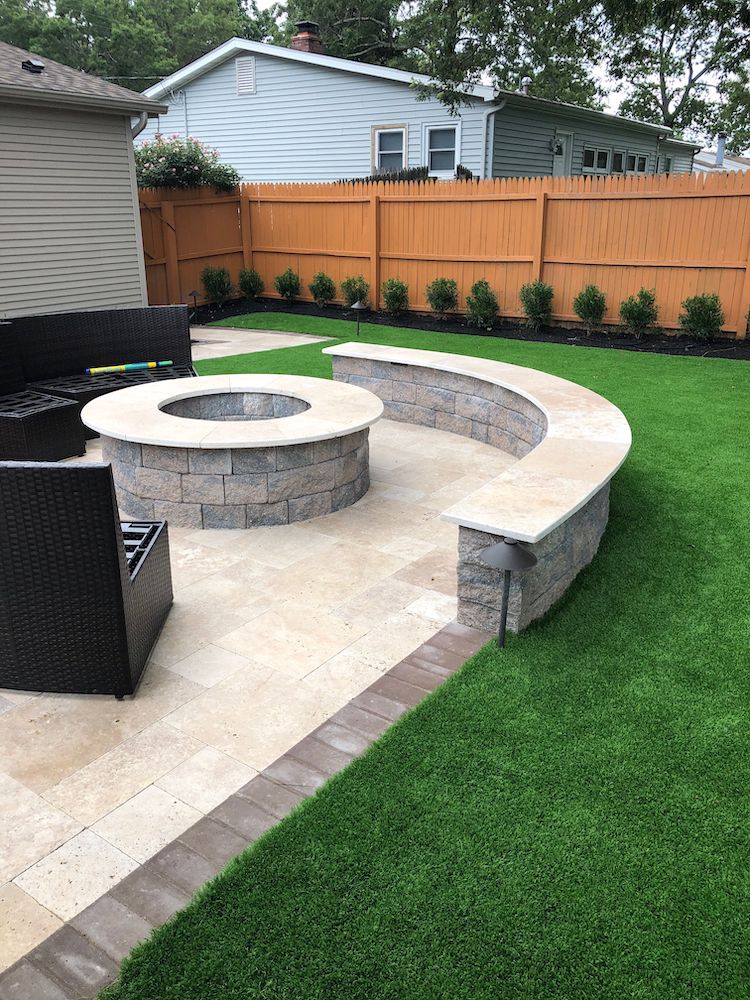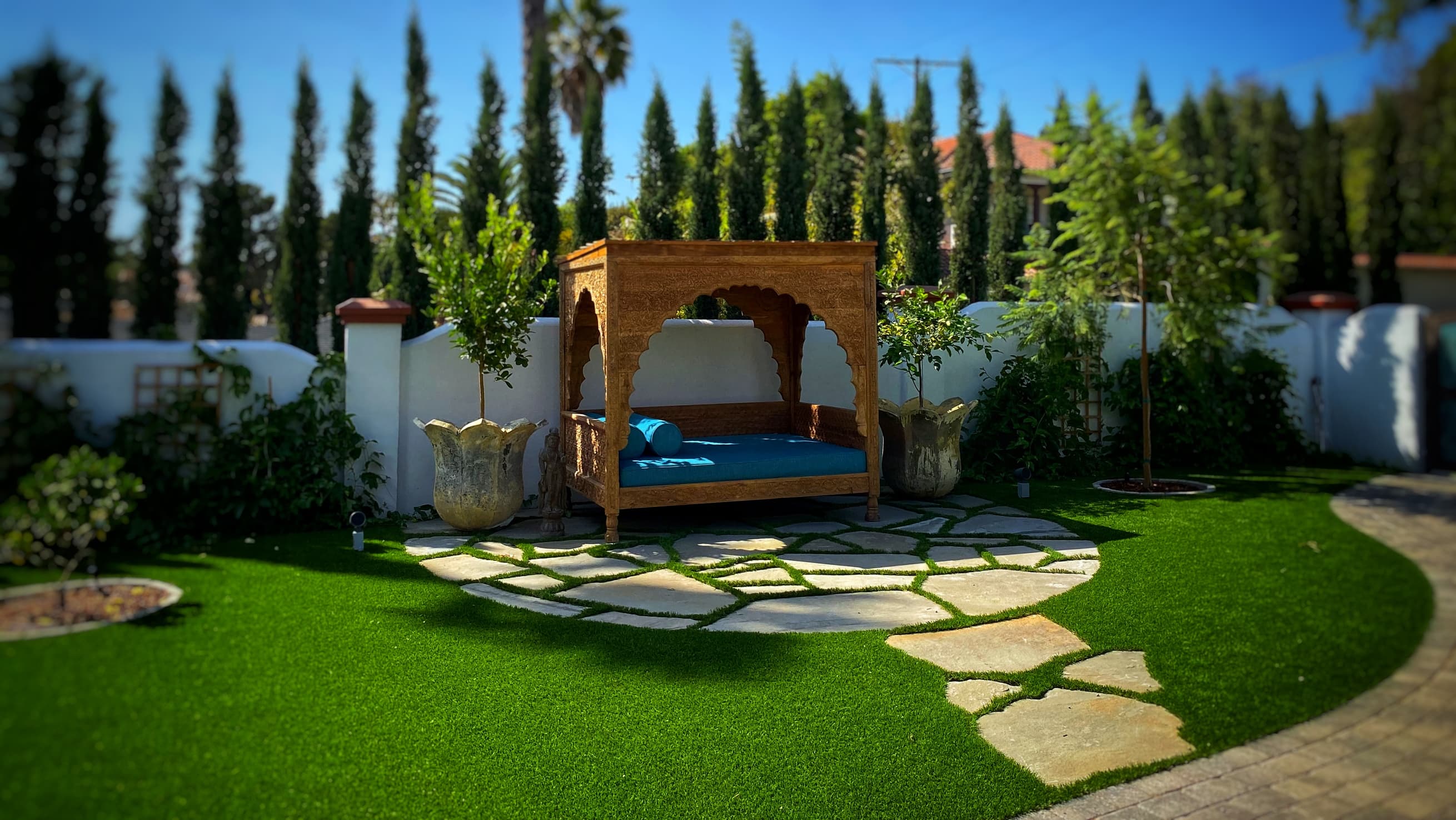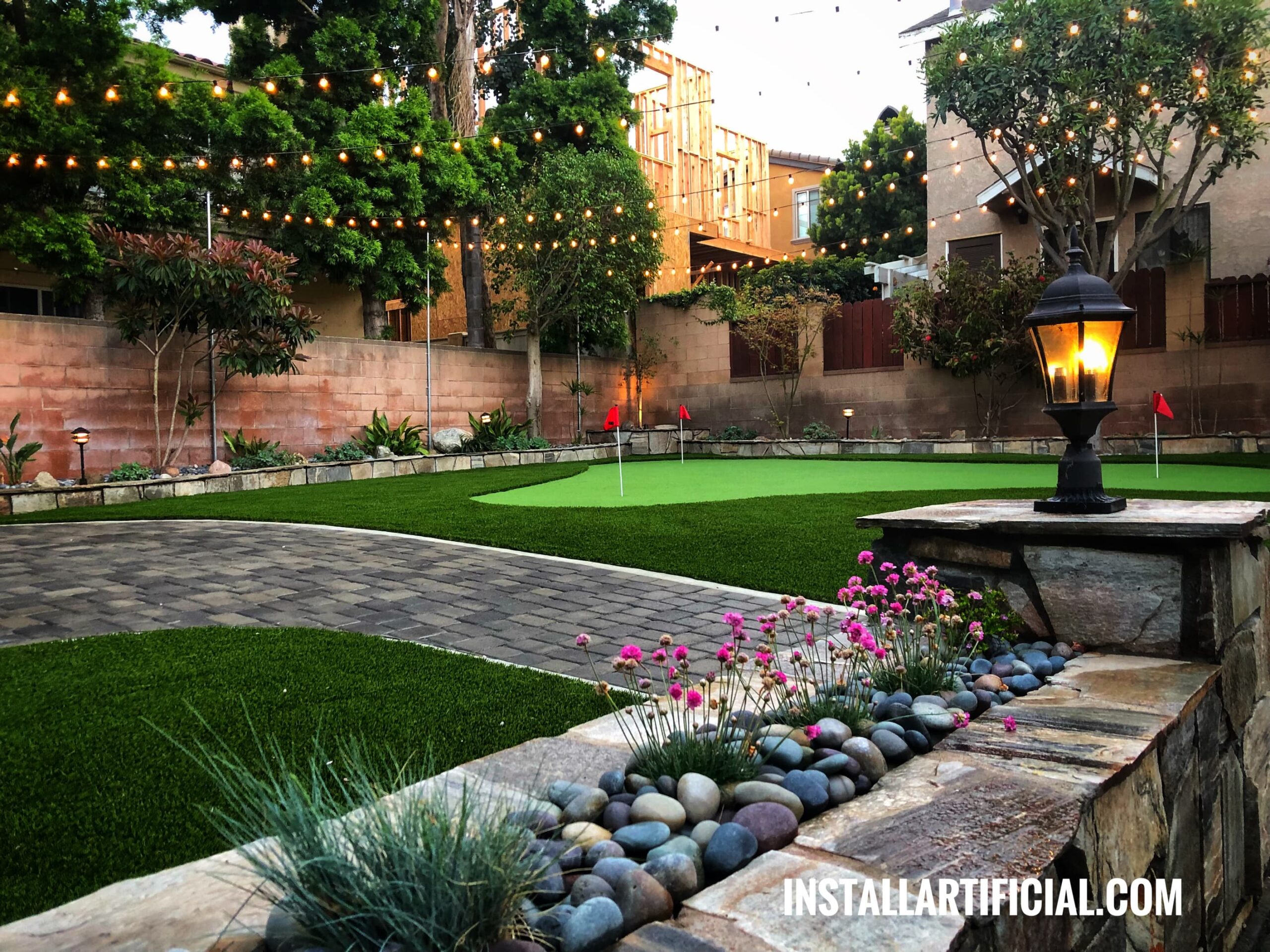Artificial grass offers a low-maintenance solution for backyard landscaping. It provides a lush, green look year-round.
Backyard landscape design with artificial grass is a growing trend among homeowners. This innovative approach offers a sustainable and visually appealing alternative to natural lawns. Artificial grass remains green and vibrant in all seasons, reducing the need for watering, mowing, and fertilizing.
It’s also highly durable and can withstand heavy foot traffic, making it ideal for families with children and pets. With various styles and textures available, artificial grass can complement any backyard aesthetic. Whether you aim for a modern look or a natural feel, this versatile option simplifies yard upkeep while enhancing outdoor spaces.
Benefits Of Artificial Grass
Artificial grass offers many benefits for your backyard landscape. It enhances beauty and reduces the need for upkeep.
Low Maintenance
Artificial grass requires very little care. You don’t need to water it. This saves time and water. There is no need to mow it. This means less work for you. Artificial grass does not grow weeds. You won’t have to pull them out.
With artificial grass, you avoid muddy patches. Your backyard stays green all year long. This makes it perfect for busy families.
Cost-effective
Artificial grass can save you money over time. You won’t need to buy lawn mowers. No need for fertilizers or pesticides. These are great savings.
Artificial grass lasts for many years. This means fewer replacements. It also helps reduce water bills. With less water needed, you save money each month.
| Natural Grass | Artificial Grass |
|---|---|
| Needs watering | Does not need watering |
| Requires mowing | No mowing needed |
| Grows weeds | No weeds |
| High maintenance | Low maintenance |
These points make artificial grass a smart choice for your backyard. Enjoy a beautiful lawn with less effort and cost.

Credit: www.bobvila.com
Choosing The Right Grass
Choosing the right artificial grass for your backyard can be tricky. It involves understanding different grass types and considering your local climate. This guide will help you navigate these choices easily.
Types Of Artificial Grass
There are several types of artificial grass available. Each type has unique features. Here’s a simple breakdown:
| Type | Features | Best Use |
|---|---|---|
| Nylon | Strong, durable, heat-resistant | High-traffic areas |
| Polyethylene | Soft, natural look, UV resistant | Residential lawns, sports fields |
| Polypropylene | Budget-friendly, less durable | Decorative areas, low-traffic zones |
Selecting Based On Climate
Your local climate plays a big role in choosing artificial grass. Some grass types handle heat better, while others are great for rainy areas.
- Hot Climates: Nylon grass is best. It won’t melt or deform.
- Cold Climates: Polyethylene grass works well. It stays soft and green.
- Wet Climates: Polypropylene grass is suitable. It drains water quickly.
Think about your climate before choosing your artificial grass. This ensures your backyard stays green and vibrant all year round.
Preparation Steps
Transforming your backyard with artificial grass involves several important steps. Proper preparation ensures a smooth installation and long-lasting results. Below are the key steps to prepare your area for artificial grass.
Measuring The Area
Start by measuring the area where you plan to install the artificial grass. Accurate measurements help you purchase the right amount of grass.
| Step | Description |
|---|---|
| Step 1 | Use a tape measure. |
| Step 2 | Measure the length and width. |
| Step 3 | Calculate the area in square feet. |
Double-check the measurements to avoid errors. Consider any irregular shapes and add extra for trimming.
Clearing The Space
The next step is clearing the space where you will lay the artificial grass. This ensures a clean and even surface.
- Remove any existing grass.
- Clear away rocks and debris.
- Use a shovel to dig up roots.
Ensure the ground is level. You may need to add or remove soil to achieve this.
Once the space is clear, you are ready for the next steps in your backyard landscape design with artificial grass.

Credit: www.installartificial.com
Installation Process
Installing artificial grass in your backyard can be a rewarding project. It transforms your outdoor space into a lush, green oasis. The installation process involves several key steps to ensure a durable and attractive finish. Below, we outline the main stages of this process.
Laying The Base
First, you need to prepare the ground. Remove any existing grass, weeds, and debris. This provides a clean slate for your artificial grass.
Next, create a solid base. Use crushed stone or gravel. Spread it evenly across the area. Aim for a depth of 3-4 inches. This layer helps with drainage and stability.
Compact the base material. Use a plate compactor or hand tamper. Ensure the surface is smooth and level. A solid base prevents future dips and bumps.
Securing The Turf
After preparing the base, roll out the artificial turf. Make sure the grass fibers face the same direction. This gives a natural look.
Trim the edges with a sharp utility knife. Fit the turf to your space perfectly. For larger areas, you may need to join multiple pieces. Use turf tape and adhesive for seamless joints.
Secure the edges with landscape staples or nails. Place them every 6-8 inches. This keeps the turf in place. Brush the grass fibers to lift and separate them. This adds to the natural appearance.
By following these steps, you can achieve a beautiful and durable backyard landscape with artificial grass. Enjoy your new green space with minimal maintenance and maximum enjoyment.
Design Ideas
Backyard landscape design with artificial grass offers endless possibilities. It is low-maintenance and durable. It stays green all year round. Here are some design ideas to make your backyard stunning.
Creating Pathways
Pathways can add structure and charm to your backyard. Use stepping stones or gravel paths. Combine with artificial grass for contrast.
Stepping stones are great for a natural look. They guide visitors through your garden. Gravel paths are easy to install and maintain. They provide a rustic appeal.
| Material | Benefits |
|---|---|
| Stepping Stones | Natural look, guides visitors |
| Gravel | Easy to install, rustic appeal |
Incorporating Plants And Decor
Plants and decor can enhance your backyard’s beauty. Use potted plants or garden beds. They add color and life. Combine with artificial grass for a lush appearance.
Decor elements like garden statues or fountains can add elegance. Fountains create a soothing sound. Garden statues add character and charm.
- Potted Plants: Easy to move, adds color
- Garden Beds: Permanent, lush appearance
- Fountains: Soothing sound, elegant look
- Garden Statues: Adds character, charming

Credit: ideal-turf.com
Maintenance Tips
Maintaining artificial grass in your backyard is easy and efficient. Follow these tips to keep your grass looking fresh and vibrant year-round.
Cleaning Techniques
Regular cleaning is essential for keeping your artificial grass in top condition. Use a leaf blower to remove leaves and debris. For pet owners, rinse the area with a hose to eliminate pet waste. A mixture of water and mild detergent can remove stubborn stains.
- Use a leaf blower weekly.
- Rinse with a hose for pet areas.
- Apply a mild detergent for stains.
Repairing Damages
Occasional repairs keep your artificial grass looking pristine. Small tears can be fixed with adhesive tape. For larger damage, consider patching with a piece of the same grass. Always ensure the backing is secure to avoid tripping hazards.
- Use adhesive tape for small tears.
- Patch larger areas with matching grass.
- Check and secure the backing regularly.
Eco-friendly Considerations
Designing your backyard with artificial grass offers many eco-friendly benefits. This approach not only enhances your landscape but also supports the environment.
Water Conservation
Artificial grass saves a lot of water. Natural grass needs regular watering. Artificial grass does not need water to stay green. This helps conserve water resources. Here’s a quick comparison:
| Natural Grass | Artificial Grass |
|---|---|
| Needs water daily | Zero water needed |
| High water bills | Reduced water bills |
Recycling Options
Artificial grass can be recycled. Many manufacturers use recycled materials. This reduces waste and supports sustainability. Some recycling options include:
- Recycling old artificial grass for new products
- Using recycled plastic in the production of artificial grass
Recycling helps keep waste out of landfills. It also conserves resources.
Cost Analysis
Choosing artificial grass for your backyard is an investment. Understanding the costs helps make an informed decision. This section breaks down the costs into two categories: Initial Investment and Long-Term Savings.
Initial Investment
The initial cost of artificial grass can seem high. It includes materials, labor, and other expenses. Below is a table showing typical initial costs.
| Item | Cost Range |
|---|---|
| Artificial Grass | $5 – $15 per sq. ft. |
| Installation | $4 – $10 per sq. ft. |
| Other Materials | $1 – $3 per sq. ft. |
The total initial cost can range from $10 to $28 per square foot. This includes the grass, installation, and other materials.
Long-term Savings
Long-term savings are a big advantage of artificial grass. It requires no watering, mowing, or fertilizing. Here are some key savings:
- Water Bills: Save on monthly water bills.
- Lawn Care: No need for lawn care services.
- Fertilizers: No more buying fertilizers.
You can save hundreds of dollars each year. These savings add up over time.
Here is a simple list of potential yearly savings:
- Water Bills: $300 – $600
- Lawn Care Services: $400 – $800
- Fertilizers and Chemicals: $100 – $200
Total yearly savings can range from $800 to $1,600. This makes artificial grass a smart choice for long-term savings.
Frequently Asked Questions
Is It A Good Idea To Put Artificial Grass In Backyard?
Yes, artificial grass is a good idea for backyards. It requires low maintenance, conserves water, and looks green year-round.
How Do I Prepare My Backyard For Artificial Grass?
Clear debris and rocks. Level the ground. Install a weed barrier. Lay a base of crushed stone. Compact the base firmly.
Do You Need Landscape Fabric Under Artificial Grass?
Yes, landscape fabric is recommended under artificial grass. It prevents weed growth and improves drainage.
What Should You Not Do With Artificial Grass?
Avoid using sharp objects that can damage the turf. Do not place heavy furniture without protection. Keep away from open flames and hot objects. Refrain from spilling harsh chemicals. Avoid allowing pets to dig or scratch.
Conclusion
Transforming your backyard with artificial grass offers numerous benefits. It’s low maintenance, eco-friendly, and always looks pristine. Enhance your outdoor space with creative designs and enjoy a lush, green yard year-round. Invest in artificial grass and experience a beautiful, hassle-free landscape.
Your dream backyard is just a few steps away!

